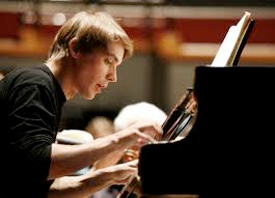by Daniel Hathaway

That was a marketing ploy by the Aeolian Piano Company which evidently helped fund a nice chunk of the orchestra’s second season, while nearly driving conductor Nikolai Sokoloff to distraction. Happily, on July 27, 2013 there was nothing whatsoever mechanical about French pianist Cédric Tiberghien’s thrilling progress through the piece in tandem with French conductor Stéphane Devène, which was at times expansive and lyrical, and at others positively seismic.
The first movement became a vast cadenza with dramatic orchestral punctuation that Tiberghien seemed to be creating on the spot — like a ruminative improvisation by an organist (a role Saint-Saëns filled for 19 years at L’église de la Madeleine). The second movement scherzo was gentle and spacious, the third a combustible tarantella. Tiberghien played with lucidity and flexibility, handsomely varying his tone to suit the mood of the moment.
The mid-sized audience (iffy weather forecasts tonight) was completely engaged and didn’t want to let Tiberghien go without giving them another piece. They got a big one: a glorious performance of Ravel’s Alborada del gracioso from Miroirs, a piece the pianist was heard trying out on one of the “Play me, I’m yours” street pianos in front of Severance Hall last Friday.
Devène opened the concert, entitled “The French Connection” with a spirited reading of Berlioz’s overture to Les Francs Juges. Though the brass produced noble sounds and there were some interesting details like a sudden outburst from the timpani (Berlioz may have played that himself), the overture seemed uninspired compared to Debussy’s La Mer and Ravel’s La Valse, which completed the program. Devène invested it with a sense of drama and occasion beyond its musical content.

Assistant conductor James Feddeck paid his official farewell to Blossom by leading the Kent/Blossom ensemble (expanded by unlisted trumpet and timpani players) in a 7 pm prelude of Debussy’s Clair de lune (arranged by André Caplet) and Beethoven’s eighth symphony. I heard the performance from the lawn. Aside from a few brass burbles, the young players did themselves proud, especially in the tricky and eccentric final movement of the symphony, when Feddeck coaxed both precise and spacious playing from the ensemble.
Published on ClevelandClassical.com July 30, 2013
Click here for a printable version of this article.



